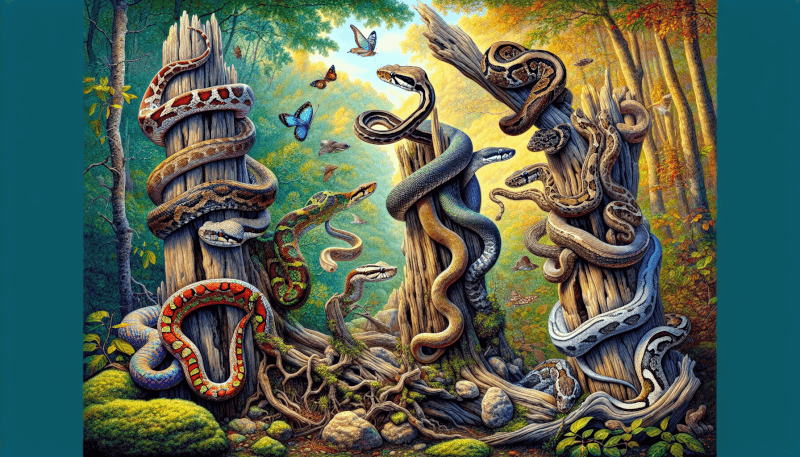Did you know that Arkansas is home to a diverse range of snake species? From venomous pit vipers like the cottonmouth and copperhead to harmless rat snakes and king snakes, the state boasts a vibrant snake population. Whether you’re a snake enthusiast or just curious about the wildlife native to this region, this article will provide you with a fascinating insight into the mesmerizing world of Arkansas snake species. So grab your binoculars and get ready to explore the slithering secrets of this captivating state!

Overview
Arkansas is home to a diverse range of snake species, which play an important role in the ecosystem. Understanding the types of snakes found in Arkansas, their behaviors, and their habitats is crucial for coexistence with these fascinating creatures. In this comprehensive article, we will explore the various types of snakes in Arkansas, their significance in the ecosystem, snakebite prevention measures, conservation efforts, and what to do in case of snake encounters.
Types of Snakes in Arkansas
Arkansas boasts both venomous and non-venomous snake species. Let’s take a closer look at some of the common snakes you might encounter in the Natural State.
Venomous Snakes
Copperhead: Copperheads are venomous pit vipers with distinctive hourglass-shaped patterns on their bodies. Their bites, though rarely fatal, may cause significant pain and swelling. It is important to watch out for these snakes, especially in forested areas or near water sources.
Cottonmouth: Also known as water moccasins, cottonmouths are large venomous snakes commonly found near swamps, marshes, and bodies of water. Their dark coloration and thick bodies make them easily distinguishable. While cottonmouths are generally not aggressive, it is best to give them a wide berth.
Timber Rattlesnake: The timber rattlesnake, with its iconic rattling sound, is the largest venomous snake species in Arkansas. These snakes are typically found in rocky and wooded areas. Timber rattlesnakes are generally docile, but caution should be exercised when encountering them in their natural habitats.
Non-venomous Snakes
Rat Snake: Rat snakes are non-venomous, beneficial snakes that help control rodent populations. These snakes are known for their impressive climbing abilities and can often be found in trees or barns. Rat snakes have a distinctive pattern consisting of dark blotches on a lighter background.
King Snake: King snakes are non-venomous constrictors known for their ability to kill and consume other snakes, including venomous ones. They are highly valued for their role in controlling snake populations. King snakes are characterized by their banded patterns of black and white or yellow.
Garden Snake: Often referred to as garter snakes, these non-venomous serpents are commonly found in grassy areas, gardens, and near water sources. They have a long, slender body and feature distinct longitudinal stripes running down their length.
Importance of Snakes in the Ecosystem
While some may fear snakes, these creatures play a crucial role in maintaining a balanced ecosystem. Here are some reasons why snakes are important:
Pest Control: Many snake species, such as rat snakes and king snakes, help control rodent populations, thus contributing to pest control efforts. By preying on rodents, snakes help protect crops and minimize the spread of diseases carried by rodents.
Ecological Balance: Snakes occupy various niches in the food chain, both as predators and prey. They help regulate the populations of small mammals, birds, reptiles, and amphibians. Maintaining a healthy snake population ensures a stable and functioning ecosystem.
Nutrient Cycling: Snakes, like all animals, play a role in nutrient cycling. They consume prey, digest it, and release waste, returning vital nutrients back to the environment.
Seed Dispersal: Some snake species assist in seed dispersal by consuming fruits and then transporting the undigested seeds to different locations as they travel, aiding in forest regeneration.

Endangered Snake Species
Arkansas is home to a few endangered snake species. It is essential to recognize and protect these vulnerable creatures to ensure their survival. Let’s learn more about two of these endangered snakes:
Scarlet Snake
The scarlet snake is a small, non-venomous snake often mistaken for the venomous coral snake due to its similar coloration. Scarlet snakes have vibrant red, black, and white bands on their bodies. Habitat loss and degradation pose significant threats to this species, which is found in only a few scattered locations in Arkansas.
Louisiana Pine Snake
The Louisiana pine snake is a large, non-venomous species primarily found in pine forests. Their distinct pattern of dark brown or black blotches on a lighter background offers excellent camouflage within their habitat. Due to habitat fragmentation and loss of suitable pine forests, the Louisiana pine snake population has declined substantially.
Preserving the habitats of these endangered snakes is crucial to their survival and the overall biodiversity of Arkansas.
Snake Habitat and Distribution
Understanding the natural habitats and distribution patterns of snakes in Arkansas is essential for knowing where to expect these reptiles and how to coexist harmoniously. Let’s explore their preferred habitats and distribution within the state.
Natural Habitats
Snakes in Arkansas exhibit a wide range of habitat preferences adapted to their specific needs. Forested areas, including hardwood forests and pine stands, are home to many snake species. Wetlands, such as swamps and marshes, are favored habitats for snakes like the cottonmouth. Grasslands, agricultural fields, and suburban gardens are also frequented by several non-venomous snake species.
Distribution Patterns
Certain snake species have specific distribution patterns within Arkansas. Timber rattlesnakes, for example, are concentrated in parts of the Ozark and Ouachita Mountains. Copperheads, on the other hand, are more widespread and can be found throughout the state. Understanding the distribution patterns helps researchers and conservationists prioritize efforts to protect snake habitats and populations.
Behavior and Reproduction
Snakes exhibit fascinating behaviors and reproductive strategies. Understanding these aspects can help remove any misconceptions or fears associated with these creatures.
Feeding Habits
Snakes are carnivores and feed on a variety of prey, including rodents, birds, amphibians, and other reptiles. Venomous snakes typically use their venom to immobilize prey, while constrictors such as rat snakes and king snakes kill their prey by suffocation. Snakes have adaptations like specialized jaws and stretchable skin to consume prey larger than their own heads.
Breeding and Reproduction
Snakes employ various reproductive strategies. Most species lay eggs, while others give birth to live young, a method known as viviparity. Spring and summer are common breeding seasons for snakes in Arkansas. After mating, females lay their eggs in suitable locations, often in underground burrows or rotting vegetation. Baby snakes hatch from eggs or are born live, depending on the species, and are left to fend for themselves from birth.
Snake Identification
Being able to identify snake species is essential for safely interacting with these reptiles. Here are some key factors to consider when identifying snakes:
Physical Characteristics
Snakes have long, slender bodies with elongated scales covering their skin. They lack limbs and ears but rely on their unique forked tongues and specialized sensory organs to navigate their surroundings. Their jaws are highly flexible, allowing them to swallow prey much larger than their heads. Snakes shed their skin periodically as they grow, leaving behind a transparent “shed” that can provide insights into their presence.
Coloration and Patterns
Coloration and patterns can also aid in identifying snakes. Different species exhibit a wide range of colors, from vibrant reds and yellows to various shades of brown, black, and green. Some snakes have distinct patterns, such as diamonds, stripes, or bands, while others have a more uniform appearance. It is essential to remember that coloration can vary within a species, making it crucial to consider multiple identification features together.
Snakebite Prevention
While snake bites are relatively rare, it is important to take precautionary measures to prevent encounters and minimize risks. Here are some safety measures to consider:
Safety Measures
Wear Appropriate Footwear: When exploring natural areas, wear sturdy, closed-toe shoes or boots to protect your feet from potential bites.
Stay on Designated Trails: Stick to well-marked trails when hiking or walking in snake-prone areas. Avoid stepping over rocks, logs, or other potential hiding spots for snakes.
Watch Where You Step: Be cautious when stepping into tall grass, brush, or rocky areas, as snakes may be concealed in these environments.
Use a Light Source at Night: Snakes are more active during warmer months and can be encountered at night. Using a flashlight when walking in dimly lit areas can help you spot any snakes in your path.
Educating the Public
Promoting public education about snakes and their importance can greatly reduce fears and misconceptions. Snakes should be appreciated for their ecological roles and the benefits they bring to the environment. By raising awareness, we can foster a better understanding of these often misunderstood creatures.
Conservation Efforts
Conserving snake populations and their habitats is vital for maintaining healthy ecosystems. Here are some key conservation efforts being undertaken in Arkansas:
Protecting Snake Habitats
Preserving and restoring natural habitats is crucial for the survival of all wildlife, including snakes. Conservation organizations and government agencies are working together to identify and protect critical snake habitats, such as forests, wetlands, and grasslands. By preserving these areas and managing them sustainably, we can ensure that snakes have suitable habitats to thrive.
Research and Monitoring
Ongoing research and monitoring are essential to better understand snake populations, behaviors, and the impacts of environmental changes. Scientists and conservationists are studying snake species in Arkansas to track their populations, identify potential threats, and design effective conservation strategies. By gathering data and staying informed, we can continually adapt conservation efforts to protect these fascinating reptiles.
Snake Encounters: What to Do
While encountering a snake can be unsettling, it is important to stay calm and know how to react appropriately. Here are some guidelines for dealing with snake encounters:
Identifying Venomous Snakes
If you encounter a snake, it is crucial to determine whether it is venomous or non-venomous. Remember the key identifying features discussed earlier, such as venomous snake characteristics like triangular heads, vertical pupils, and rattles. If uncertain, it is always safer to assume a snake is venomous and give it a wide berth.
Snake Removal and Relocation
If you find a snake in or near your home and prefer it to be removed, it is highly recommended to contact a professional snake removal service. Attempting to remove or handle a snake without proper training can be dangerous for both you and the snake. Professionals have the knowledge and equipment to safely relocate snakes without causing harm.
With a better understanding of Arkansas’s snake species, their behaviors, and the importance they hold in the ecosystem, you can foster coexistence, promote conservation efforts, and appreciate the intricate role snakes play in the natural world. Remember, by respecting and protecting these creatures, we contribute to the preservation of a diverse and thriving environment.


